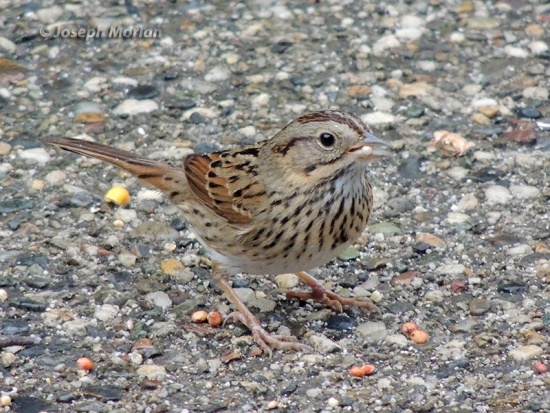
Photo © by Joseph Morlan
Pacifica, San Mateo County, California, USA, 21 January 2020
- Melospiza lincolnii
Identification
13-15 cm. (5-6in)
Crown has 2 rusty stripes; gray eyebrow. Buff band, finely streaked with black, across upper breast.
Similar Species
Lincoln's Sparrow is more elusive compared to the similar and more familiar Song Sparrow. Lincoln's Sparrow is more finely patterned on its back and has a distinctive buffy coloration across its breast. It is also smaller than the resident Song Sparrow and has a shorter tail.
Variations
Subspecies differ slightly in size and color. The widespread nominate race is more ruddy in color. The smaller west-coast race M. l. gracilis is more yellowish with broader shaft streaks above and thus is more contrasting in its dorsal pattern. However there is much overlap between the races and their validity has been questioned by some authors.
Distribution
Nests across the boreal zone of Canada and the northern United States, south in the western mountains to Arizona and southern California. Winters southern United States to Mexico and northern Central America.
Taxonomy
Subspecies
Three subspecies are recognized[1]:
- M. l. lincolnii: NW Alaska to Canada and n US; > to Baja and Guatemala
- M. l. gracilis: Coastal s Alaska and c Br. Columbia; > to central California
- M. l. alticola: Mts. of Oregon to Ariz. and New Mexico; > to Guatemala
Habitat
Brushy bogs, willow or alder thickets; winters in woodland thickets and brushy pastures. Migrant in brushy areas.
Behaviour
Usually secretive and shy.
Diet
Feeds on a variety of foods. During the breeding season mostly arthropods, including insect larvae, adult beetles, and flies. In winter they take small seeds and terrestrial invertebrates when available. Occasionally uses feeders.
Breeding
They lay 4 or 5 pale green eggs, heavily spotted with brown, in a cup of grass well concealed in forest undergrowth.
Vocalisation
The song is a rich, gurgling, wren-like song rising in the middle and dropping abruptly at the end. Call is a hard "tick" and a buzzy "bzzt" like an electric spark.
Movements
Migratory; in parts of the West it can be found in both summer and winter, although at different elevations.
References
- Clements, J. F., T. S. Schulenberg, M. J. Iliff, S. M. Billerman, T. A. Fredericks, B. L. Sullivan, and C. L. Wood. 2019. The eBird/Clements Checklist of Birds of the World: v2019. Downloaded from http://www.birds.cornell.edu/clementschecklist/download/
- Ammon, E. M. (2020). Lincoln's Sparrow (Melospiza lincolnii), version 1.0. In Birds of the World (A. F. Poole and F. B. Gill, Editors). Cornell Lab of Ornithology, Ithaca, NY, USA. https://doi.org/10.2173/bow.linspa.01
- Byers, C., J. Curson, and U. Olsson. 1995. Sparrows and Buntings: A Guide to the Sparrows and Buntings of North America and the World. Houghton Mifflin, Boston.
- Rising, J. (2017). Lincoln’s Sparrow (Melospiza lincolnii). In: del Hoyo, J., Elliott, A., Sargatal, J., Christie, D.A. & de Juana, E. (eds.). Handbook of the Birds of the World Alive. Lynx Edicions, Barcelona. (retrieved from http://www.hbw.com/node/61916 on 16 April 2017).
Recommended Citation
- BirdForum Opus contributors. (2025) Lincoln's Sparrow. In: BirdForum, the forum for wild birds and birding. Retrieved 11 May 2025 from https://www.birdforum.net/opus/Lincoln%27s_Sparrow
External Links
GSearch checked for 2020 platform.1




